Discover the diverse and colorful world of woodpeckers in British Columbia as we take you on a journey to explore the 13 unique species that call this province home.
From the striking red plumage of the Lewis’s Woodpecker to the elusive Black-backed Woodpecker, each species has its own unique characteristics and habits that make them fascinating to observe and learn about.
So come along and join us as we unveil the hidden treasures of the woodpecker kingdom in British Columbia.
| Image | Name |
|---|---|
 | Northern Flicker |
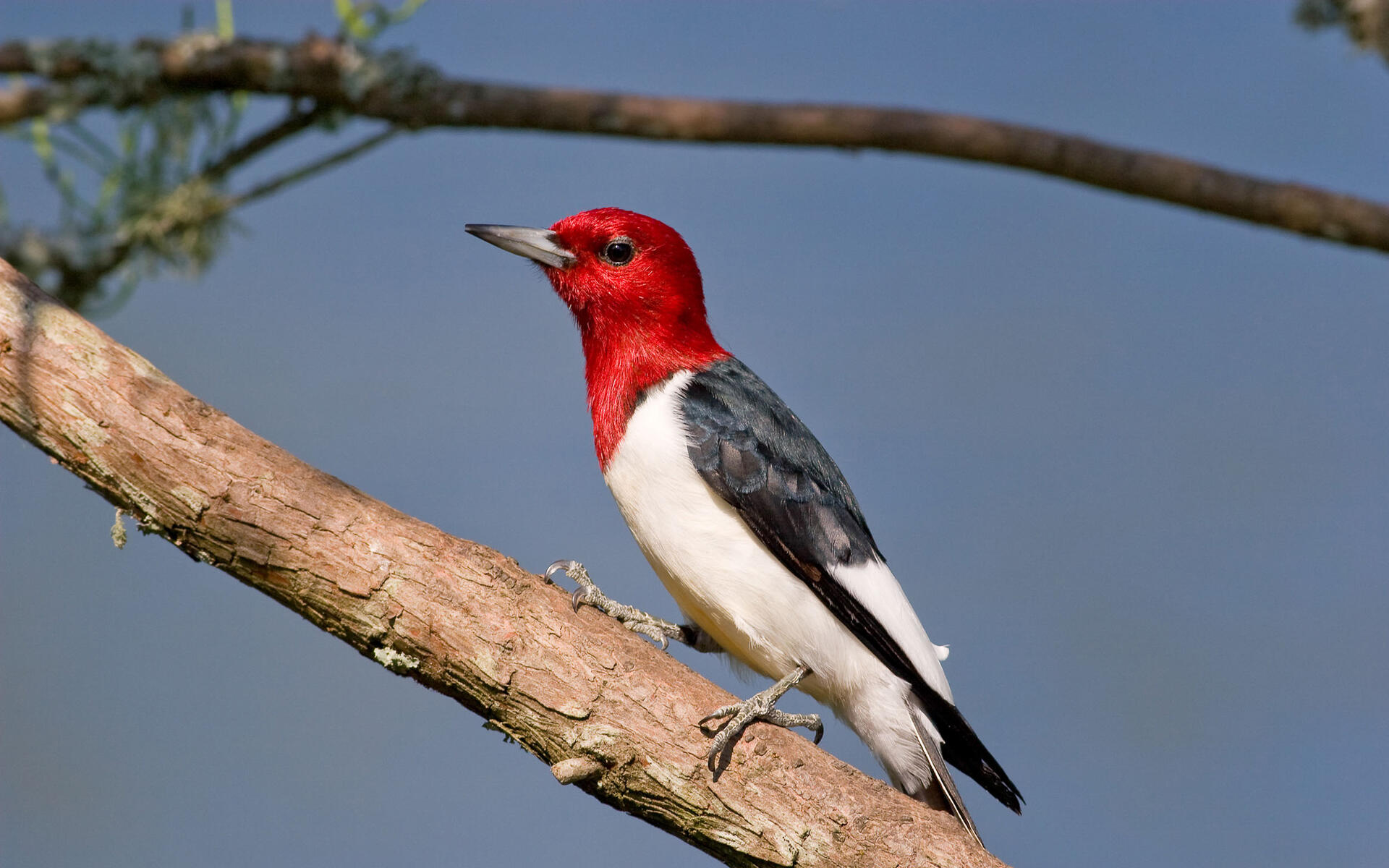 | Red-Headed Woodpecker |
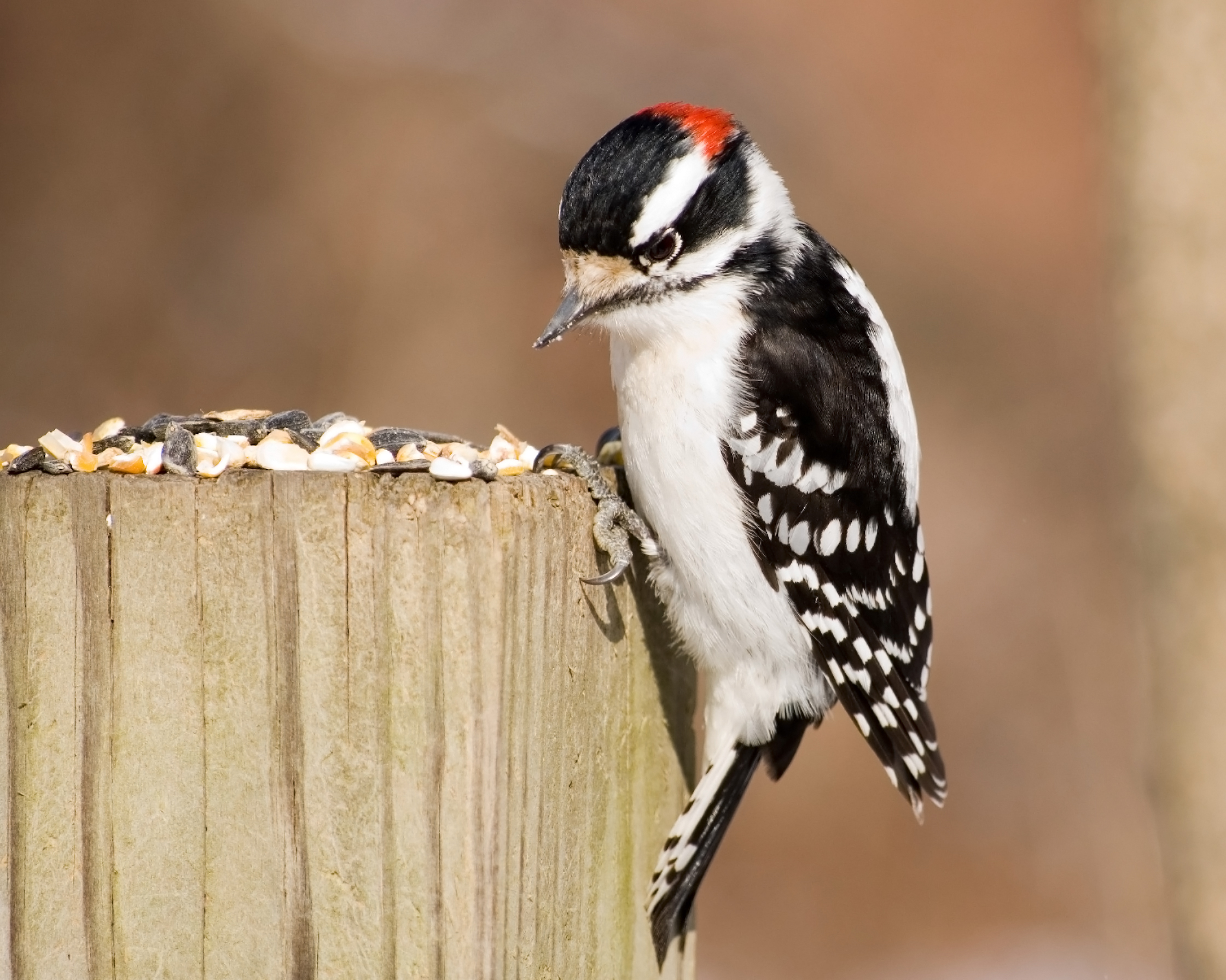 | Downy Woodpecker |
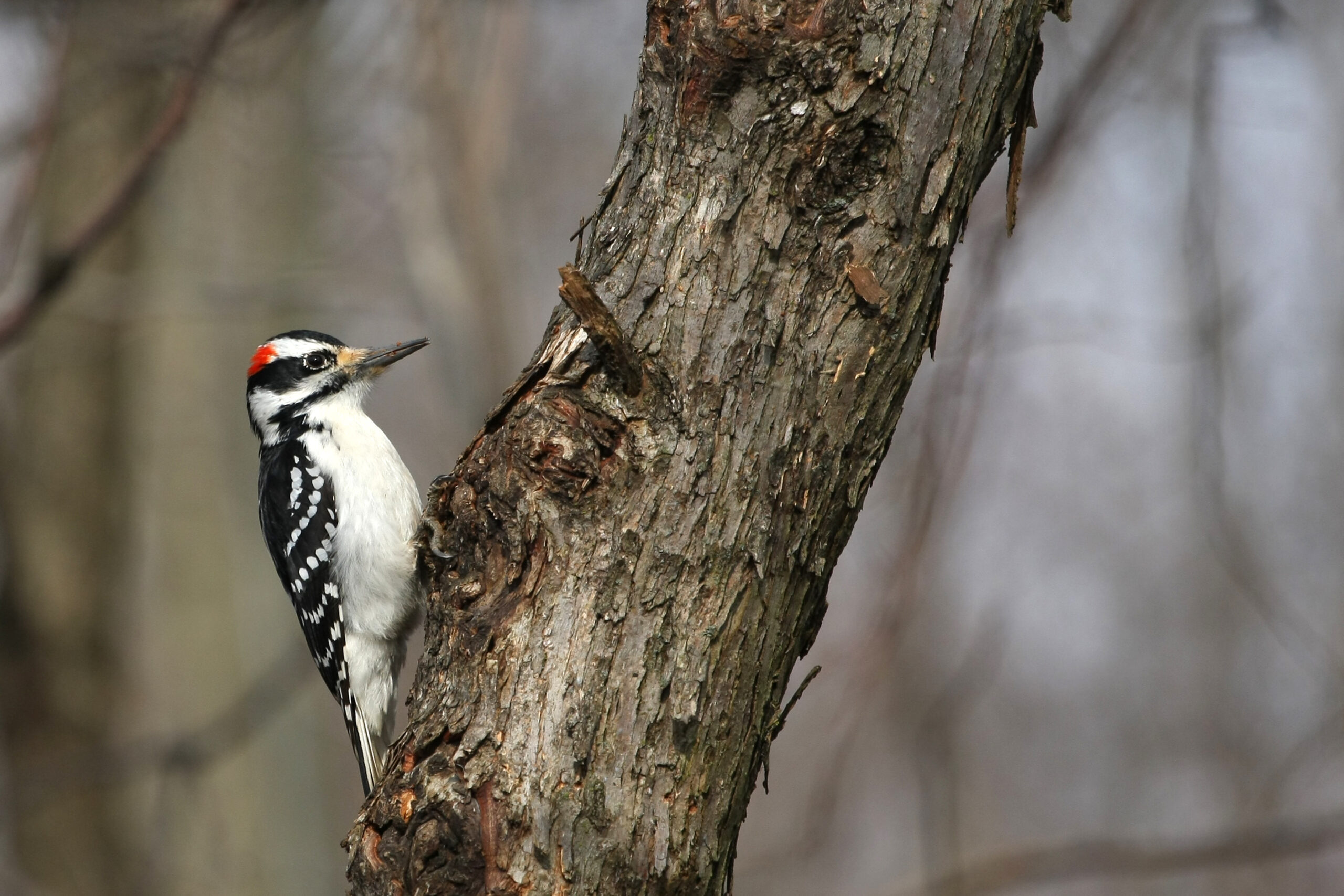 | Hairy Woodpecker |
 | Pileated Woodpecker |
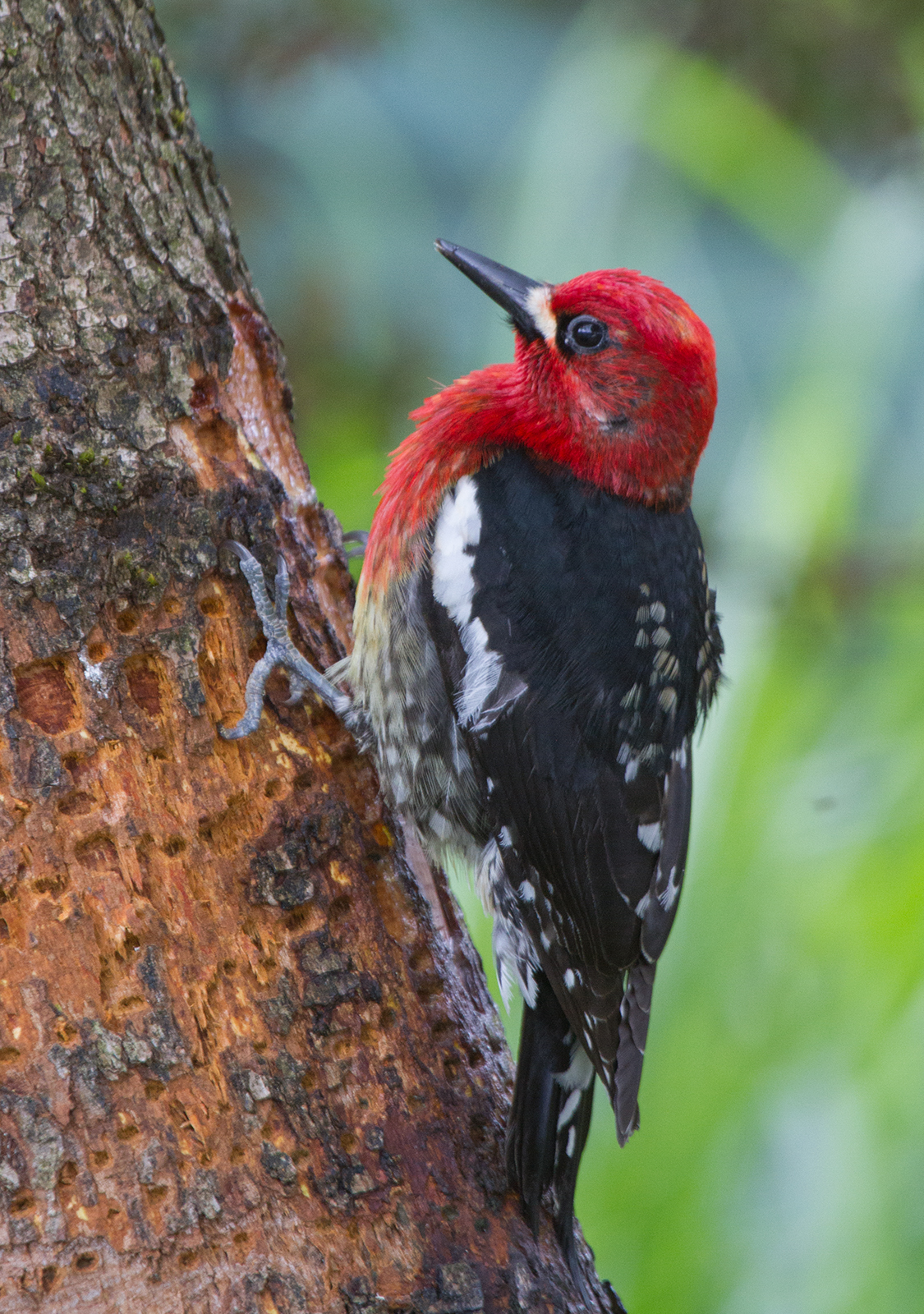 | Red-breasted Sapsucker |
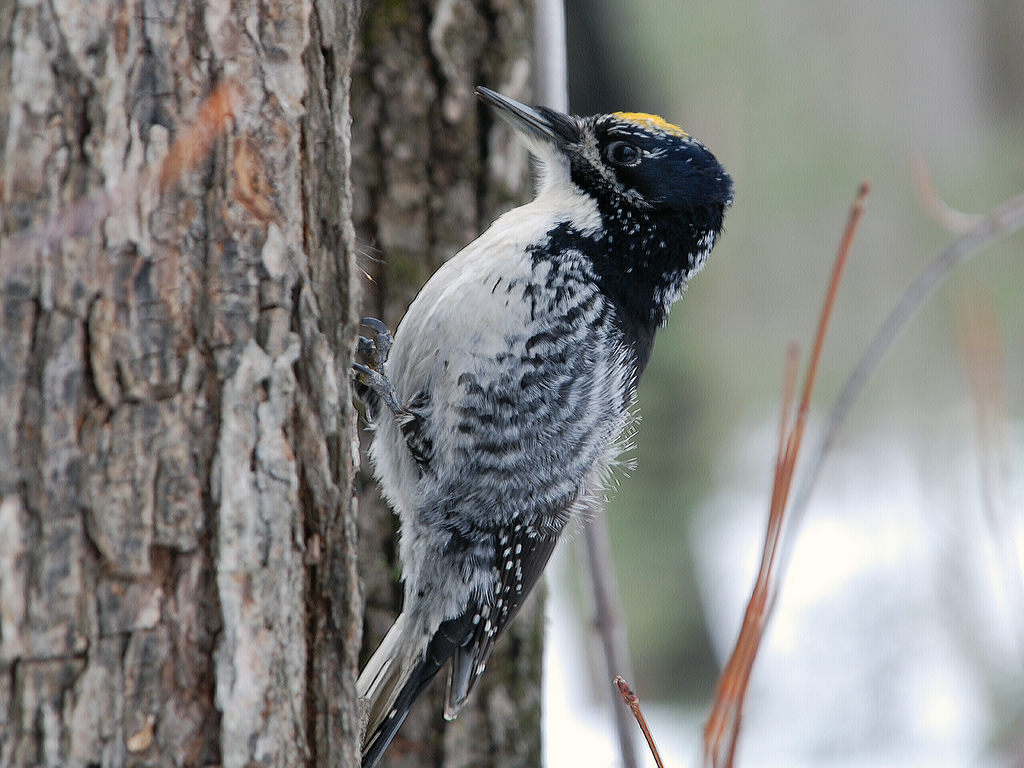 | American Three-toed |
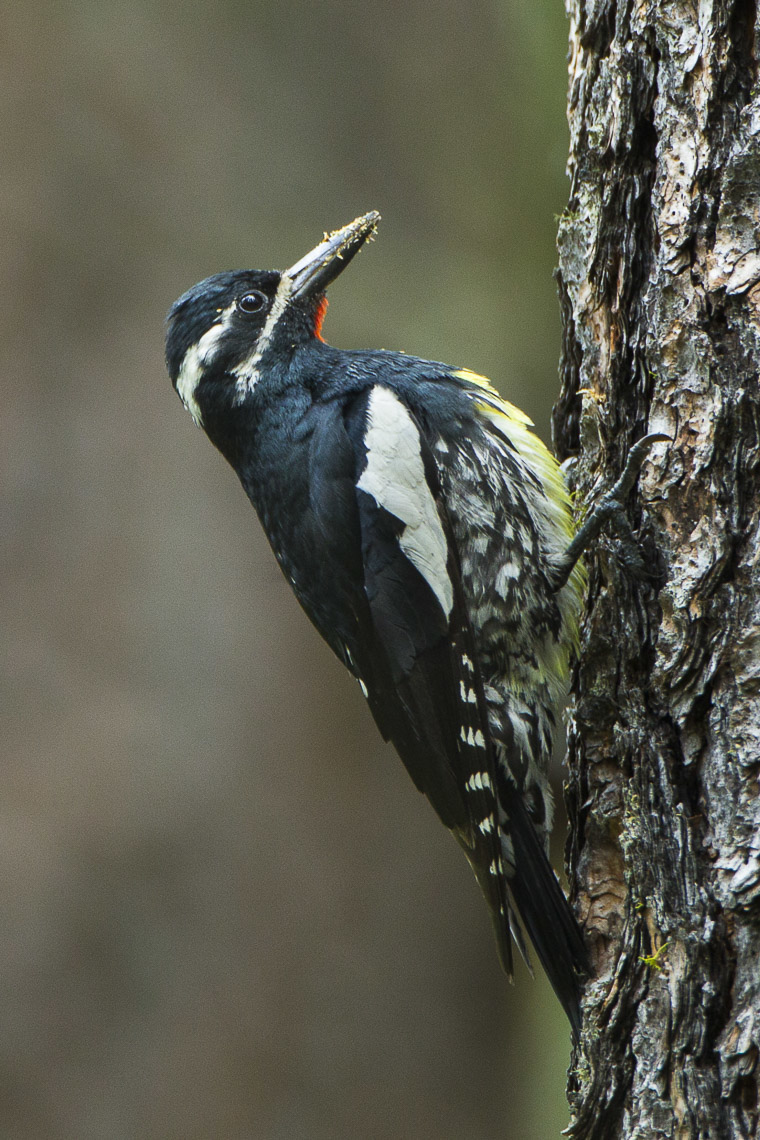 | Williamson's Sapsucker |
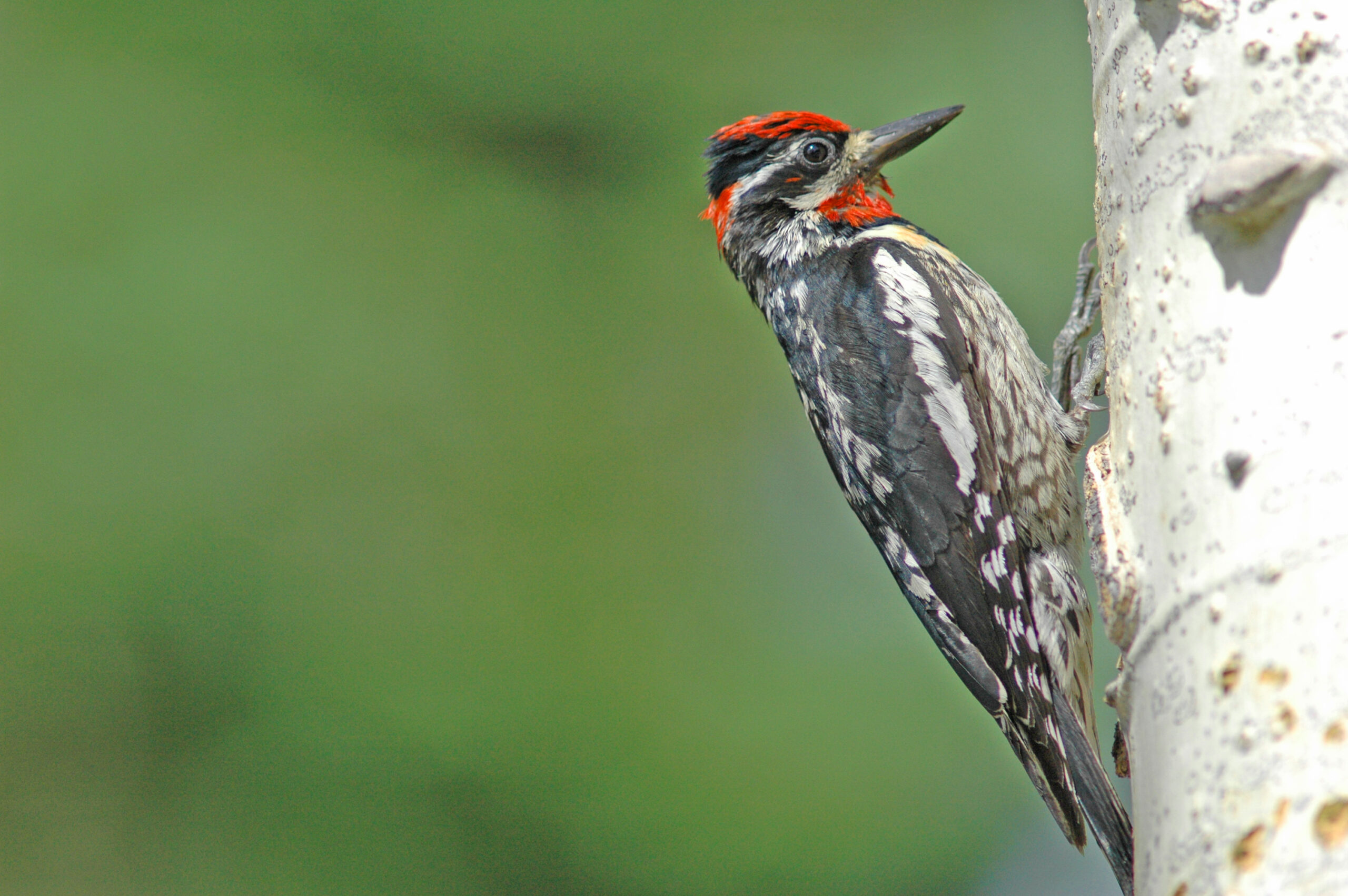 | Yellow-Bellied Sapsucker |
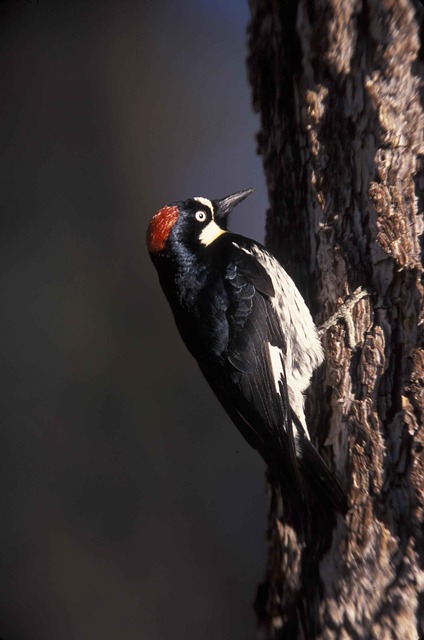 | Acorn Woodpecker |
 | Lewis's Woodpecker |
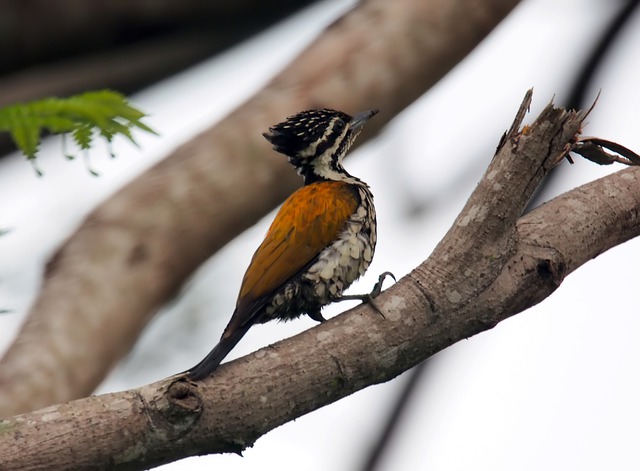 | Black-backed Woodpecker |
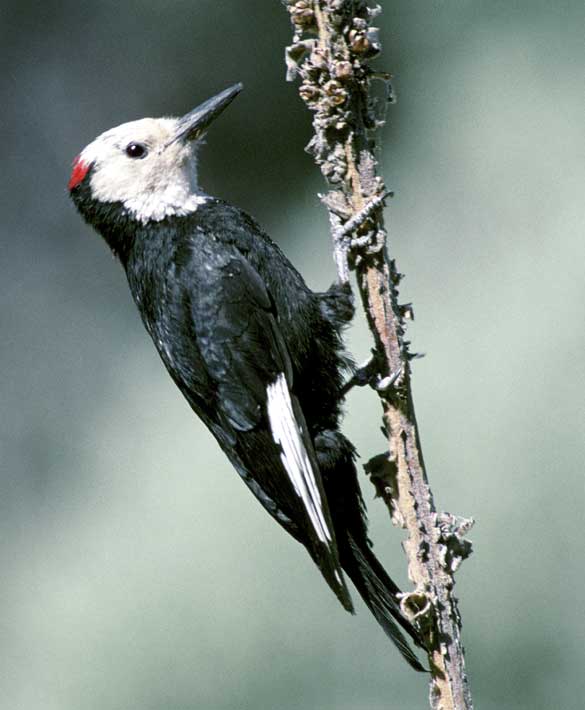 | White-headed Woodpecker |
Types of Woodpeckers in British Columbia (BC)
1. Northern Flicker

The Northern Flicker is a year-round inhabitant of British Columbia, and it is the most often sighted woodpecker, being included in 32% and 37% of summertime and winter bird lists provided by bird watchers.
The Northern Flicker is a big brown woodpecker with vivid black-spotted feathers, a white spot on its back in flight, and a red rear of the neck in males.
Depending on their geographic origin, Northern Flickers may have either red or yellow streaks on their tail and wings.
Birds with red shafts inhabit the west, whereas birds with yellow shafts prefer the east.
You may find them throughout Canada and the United States, but the ones that spend the summer breeding north of the border go south for the winter.
The cry of the Northern Flicker is a loud, ringing shriek. In tree hollows, they produce a clutch of 5 to 9 white eggs.
Their bent bill allows them to easily dig up the beetles, ants, seeds, and fruits that make up the bulk of their diet.
Drumming by a Northern Flicker is particularly audible since the bird is larger than average for a woodpecker.
They also emit a very drawn-out call that goes something like “flicks – flicks – flicks”.
Northern Flickers are common in parkland, grassy areas, and even suburban areas.
Sometimes you might find them scrounging for food on the floor.
You’re more likely to observe Northern Flickers at a birdbath than at a feeder, so it’s a good idea to put up a pedestal fountain or a warmed birdbath in the winter.
They may be enticed with huge hoppers, suet cages, or platform feeders stocked with hulled sunflower seeds, peanuts, black oil sunflower seeds, suet, safflower seeds, millet, and broken corn.
Flickers may be enticed to nest in your yard by planting bayberries, grapevines, elderberries, or hackberries and by constructing a nest box specifically for them.
2. Red-Headed Woodpecker
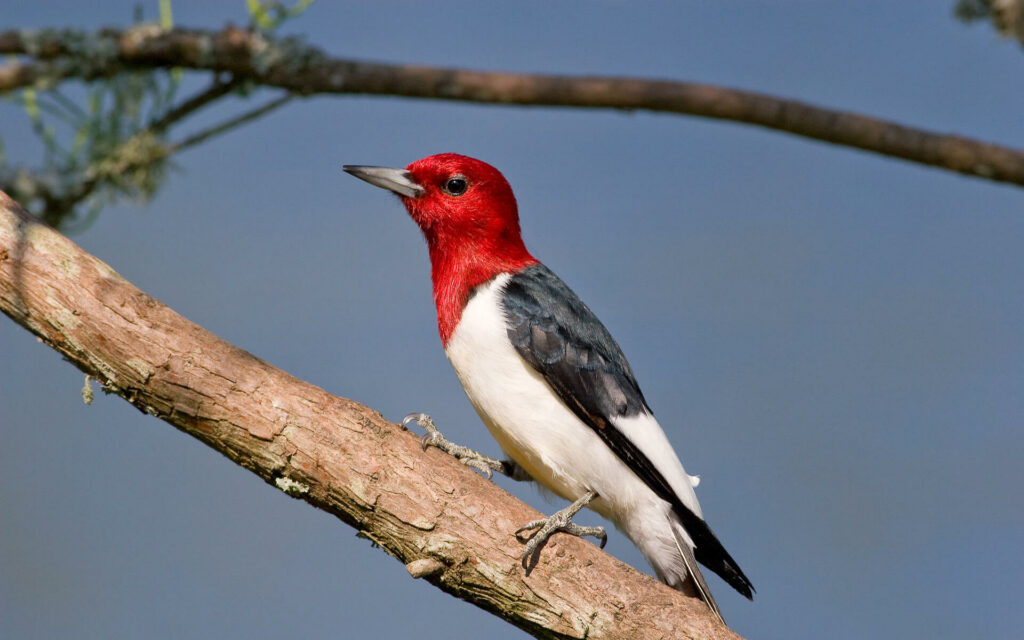
There have been only a few documented sightings of red-headed woodpeckers across British Columbia, the most recent being in 2020.
These woodpeckers are among the simplest to recognize due to their striking red heads and black and white patterns.
The red-headed woodpecker is a robust bird with a strong spike beak.
They are black on the back, with white stripes on the wings. Their tails are short.
You may see a red-headed woodpecker in the southernmost parts of Canada and the central and eastern United States.
Based on the success of their acorn harvests, those living in the northern and eastern parts of the range may move farther east and south.
Territories may be strongly defended, with birds and ducks removing or killing the eggs of other species.
Like some other woodpeckers, the red-headed variety may be seen picking insects out of the air or out of cracks.
Only approximately a third of their food consists of insects like midges, beetles, grasshoppers, and honeybees.
Nuts, berries, and seeds make up the remaining two-thirds.
As well as their own young, red-headed woodpeckers can sometimes steal birds’ eggs or even rodent nestlings.
The red-headed woodpecker, known for its piercing cry, builds its nest in tree holes, sometimes returning to the same hole year after year to deposit its four or five white eggs.
Tragically, between 1966 and 2014, habitat degradation caused a catastrophic 70% reduction in Red-headed Woodpeckers.
They thrive in places like open woods, pine savannas, farms, and marshes with dead trees.
They occasionally stop by bird feeders in yards.
3. Downy Woodpecker

The winter months in British Columbia are particularly good for seeing Downy Woodpeckers in the province’s woods and forests.
During the colder months of the year, this species of woodpecker is the second most often seen by birdwatchers throughout British Columbia.
About 9% of the time throughout the summertime, they are included.
The Downy Woodpecker’s plumage is predominantly black, having a white stripe along the middle of its back.
There’s a red spot on the rear of the males’ heads, too.
It has many physical characteristics with the Hairy Woodpecker, although it is about a third shorter and has a noticeably smaller beak than other woodpeckers.
The Downy Woodpecker is the most popular species to visit bird feeders.
The Downy Woodpecker may be found almost everywhere in Canada or the United States.
Neither the southern border to Mexico nor the northern border with Canada has any of these species.
Bird feeders often attract Downy Woodpeckers.
They are entertaining to observe because of their high-pitched “pik” sound and their “descending whiny” cry.
Between three and eight tiny white eggs (0.9 inches) are laid by female Downy Woodpeckers in the nest chambers they excavate in dead trees.
The downy woodpecker’s diet consists mostly of nuts but also includes berries, insects, cereals, and acorns.
Hummingbirds may occasionally be observed consuming nectar from feeders.
There are several species of woodpeckers, but the Downy Woodpecker is the most frequent.
In comparison to the Hairy Woodpecker, with whom they share a similar appearance and call, their drumming is a little slower, allowing you to pick out the individual beats more clearly.
Typically, Downy Woodpeckers are observed in close proximity to other tiny birds, like chickadees and nuthatches.
They frequent feeders and may be spotted in orchards, gardens, open forests, and parkland. Also, look for them in the midst of the thick weeds.
4. Hairy Woodpecker
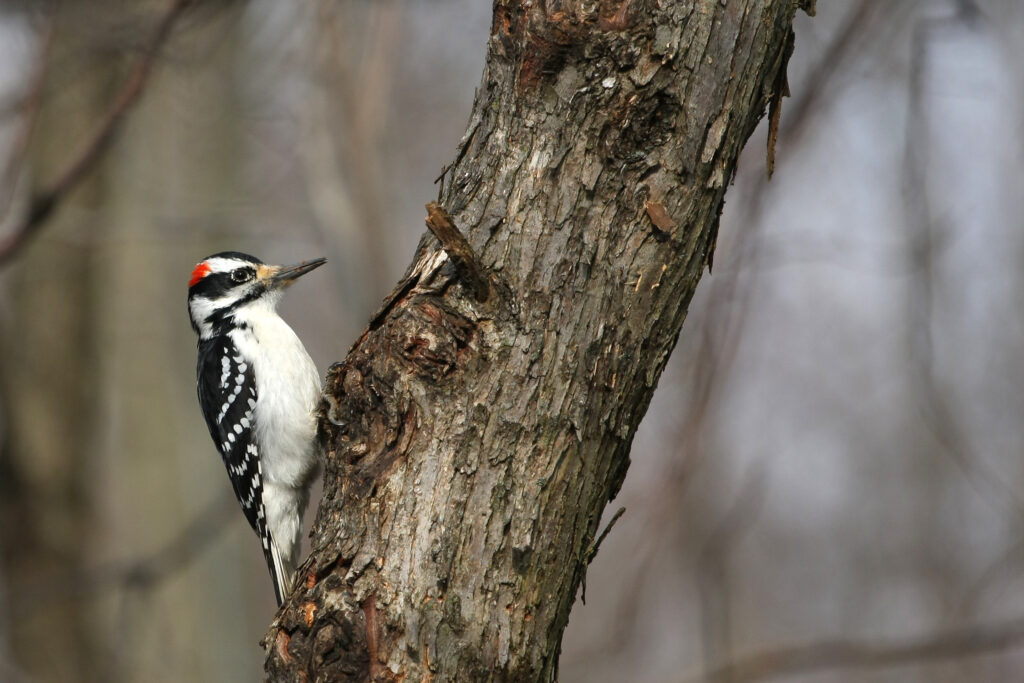
Over 7% of winter checklists across British Columbia include Hairy Woodpeckers, making them the third most often sighted woodpecker in the province.
There is a summertime uptick in the frequency with which they are included on lists (6 percent).
Hairy Woodpeckers are black and white woodpeckers that are about the length of a crow.
A red blaze may be seen at the top of the males’ heads.
In appearance, Hairy Woodpeckers appear identical to the Downy woodpecker; however, they are bigger and also have longer beaks.
It’s not always easy to tell them distinct, especially when they’re located in the same places.
They are widespread across the United States, into Mexico, and even much of Canada.
Small but strong, these birds may be heard whinnying or making spectacular peak sounds at garden feeders.
Ants, bark beetles, and beetle larvae make up the bulk of a Hairy Woodpecker’s diet, although they will also consume spiders, millipedes, caterpillars, bees, and moth pupae.
The female Woodpecker lays anywhere from three to six eggs, all of which are white, in the holes of felled trees or tree pieces.
The drumming of the hairy woodpecker is reminiscent of that of the Downy woodpecker, although it is quicker, and the individual drums are less audible.
Hairy Woodpeckers are common in forests, where they perch on the trunks or primary branches of huge trees, but they may also be seen in wooded areas, parks, and even graveyards.
5. Pileated Woodpecker

The Pileated Woodpecker is a frequent sight across British Columbia, showing up on checklists at a rate of 6% during the summertime and 5% during the winter months.
Pileated Woodpeckers are the largest species of Woodpeckers across North America, and they stand out due to their distinctive red triangular crest.
Almost the proportions of a crow, this woodpecker is among the largest in the world.
The bottom of its wings is white, and its body is predominantly black, featuring a white stripe.
Males also have an extra red stripe across their cheeks.
Their year-round range includes the eastern United States, the far western United States, and most of Canada.
Pileated Woodpeckers consume a wide variety of foods, including beetle larvae, carpenter ants, termites, nuts, and fruit like sumac berries, elderberry, blackberries, dogwood, and various insects found in logs and dead trees.
They have a high-pitched, whining cry and a booming, resonant pounding.
Pileated Woodpeckers utilize cavities in dead trees for breeding, and because they typically build a new nest every year, the previous one is frequently reused by other kinds of birds.
They typically lay anywhere from three to five white eggs.
Because of their massive size, the drumming of the pileated woodpecker is resounding and thunderous.
They also produce a noise that sounds like chuckling and a ‘wukk-wukk-wukk’ call.
These birds like suet and may be found at home feeders as well as in more established woods or those that have been flooded.
They leave behind telltale square or rectangular holes in trees.
6. Red-breasted Sapsucker
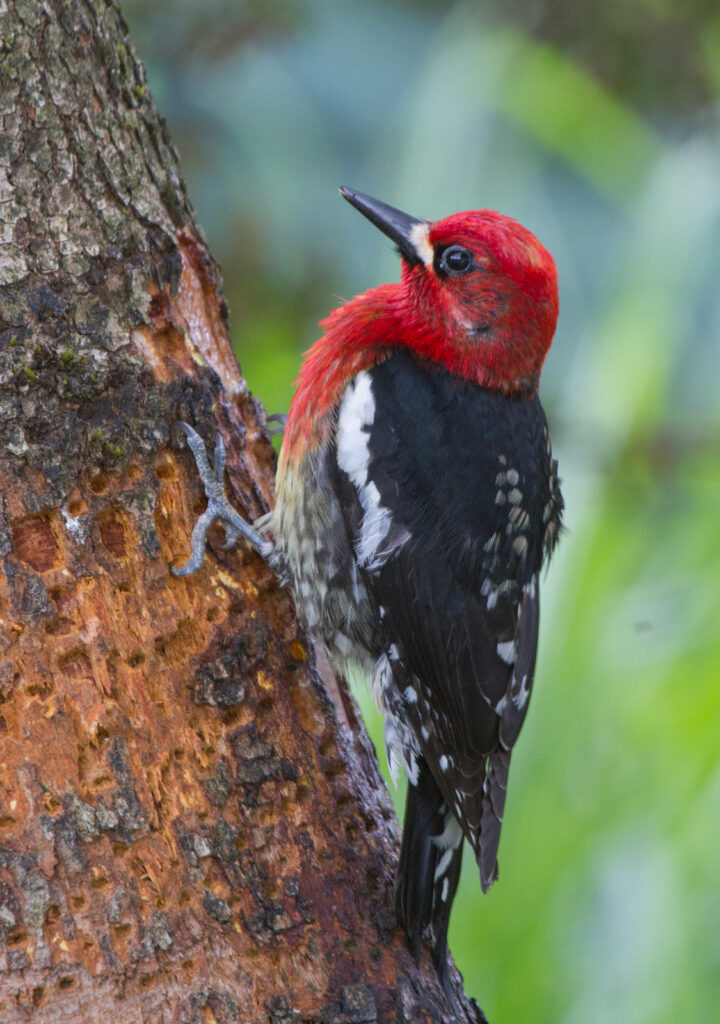
The British Columbia Pacific Coast provides a home to many populations of red-breasted sapsuckers.
The Red-breasted Sapsucker is a woodpecker of moderate size, distinguished by its vivid red chest and head.
When their wings are folded, you can see a white line running down the length of each one and a white dot in front of each of their eyes.
Both sexes seem identical in youngsters, although the adult redhead is no longer present.
Northern Red-breasted Sapsuckers have more red on their heads than their southern Californian counterparts.
From their interior breeding grounds across California and British Columbia, red-breasted sapsuckers make their way to the coast, where they spend the winter.
They also eat insects and fruit in addition to tree sap.
Look for parallel rows of little holes in the trunk of fir trees to locate Red-breasted Sapsuckers.
Cut fruit might attract sapsuckers to your property, but only if you have quite a lot of conifer trees.
7. American Three-toed

The American Three-toed Woodpecker is a resident of British Columbia and may be spotted all across the province.
The American Three-toed Woodpecker is easily identifiable by its distinctive yellow forehead band, black and white banding on the back, and white markings on the wings.
Their undersides are white, and they have black stripes along either side.
Although they resemble Black-backed Woodpeckers, these birds are much smaller. Females possess black foreheads instead of yellow bands.
In spite of their little stature, these creatures pack a tremendous punch because of the extra leverage afforded by the three toes they use in place of the typical four.
The American Three-toed Woodpecker is a species of woodpecker that is native to Alaska and Canada but may also be spotted in the western highlands of Nevada, Oregon, and even New Mexico and Arizona.
Those who go farther east will find them in the Upper Midwest states of Minnesota and Michigan.
It’s possible that they’ll go south and away from the Arctic in the winter.
They like to hang out in woods that have been hit hard by natural disasters like floods, fire, or storms and so contain plenty of insects.
They stay put and lay up to four eggs in their nests throughout the months of May and June.
8. Williamson’s Sapsucker
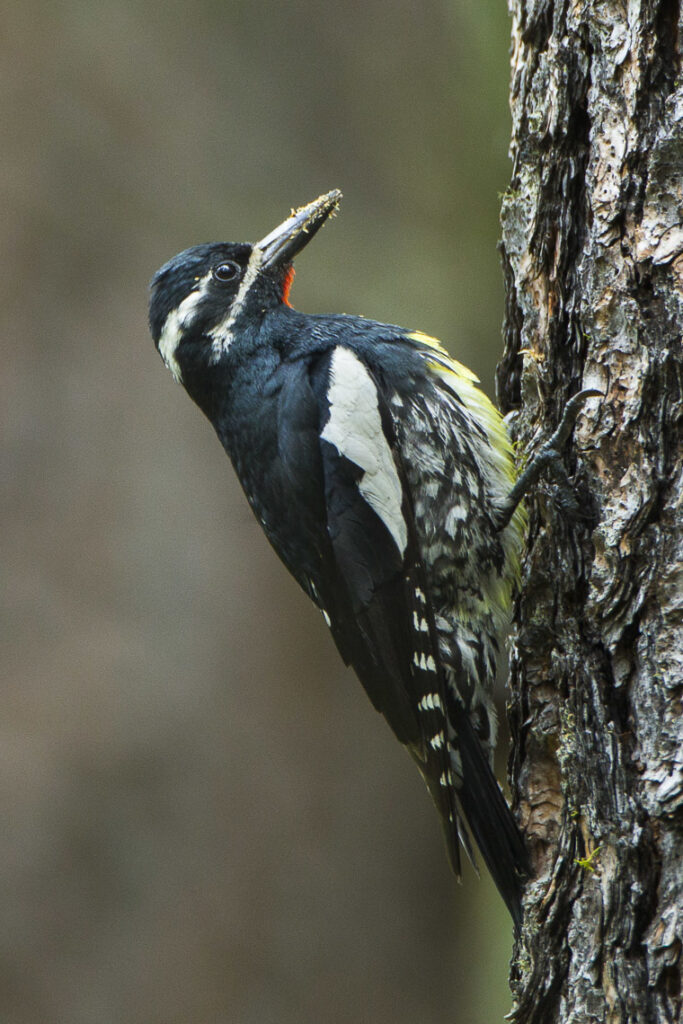
Though sightings of Williamson’s Sapsuckers within British Columbia are quite rare, they may be made from March through September in the southeast region of the state.
Male Williamson’s Sapsuckers seem more black as compared to other woodpeckers, having vertical wing spots, glossy black rear, a yellow abdomen, and a red neck.
The females possess the standard brown head and black chest band in addition to the more frequent black and white design on their backs.
Williamson’s Sapsuckers are nomadic; during the summertime, they breed in the western mountains, and during the winter, they go to the southern United States and Mexico.
During the spring and early summer, they subsist mostly on the sap of fir trees but switch to eating more insects like flies, ants, and beetles in the warmer months.
Seeds and fruit are common wintertime fare.
9. Yellow-Bellied Sapsucker

In British Columbia, Yellow-bellied sapsuckers may be seen throughout the summertime during the mating season before migrating south for the winter.
It’s fair to say that a Yellow-bellied Sapsucker is around the proportions of a robin.
The male possesses a redneck, while the female has red on her forehead.
After reproducing in the summer, they go south to spend the winter.
Their summer range includes the northeastern United States and Canada.
The brush-tipped tongues of Yellow-bellied Sapsuckers are used to bore holes in trees and extract the sap.
Yellow birch, paper birch, sugar or red maple, and hickory saplings may be infested if you’re not careful since they bore holes in neat horizontal rows.
In order to keep the sap flowing, the holes must be kept in good condition.
They lay a clutch of 3 to 5 white eggs in tree hollows and produce a loud mewing sound during incubation.
Deciduous forests that are still relatively young, usually on maple or birch trees, where create tidy rows of sapwells for the feast.
Yellow-bellied Sapsuckers are seldom seen at bird feeders, although they occasionally visit in search of suet.
10. Acorn Woodpecker

Although they are not native to British Columbia, Acorn Woodpeckers have been observed in and around the Vancouver area.
The Acorn Woodpecker’s red hat, white face, black spot all around the beak, and black across the rear of the head and back give them a striking clownlike appearance.
There are black marks on their otherwise white abdomen. Less red may be seen on the heads of female Acorn Woodpeckers compared to males.
Unlike other woodpeckers, Acorn Woodpeckers form vast colonies in which they feed on acorns together and store them for the winter.
Oak woodlands are home to these people from western Oregon and California via Texas and farther south through Central America and Mexico.
Clownish in appearance, the Acorn Woodpecker’s diet is everything but funny: it includes the storage of dead insects in a “pantry” and the consumption of its own species’ eggs.
The Acorn Woodpecker’s wintertime drilling of many holes into dead trees creates a convenient granary for storing the nuts it harvests.
When stored acorns dry up and shrink, they will relocate to narrower holes.
When it relates to stowing things away, insects are included, although their corpses are usually abandoned in some unsightly crack or crevice.
Eggs, even those of their kind, and fruit are also viable food sources.
11. Lewis’s Woodpecker

Rare Lewis’s Woodpeckers may be seen in the summertime in Southwestern British Columbia.
Lewis’s Woodpeckers are the only woodpeckers you’ll ever see that doesn’t pound on trees; instead, they grab insects in flight.
As if that weren’t enough to distinguish it from its relatives, it also has a dark grey collar, a dark red face, and a pink belly.
The range of the Lewis Woodpecker stretches from British Columbia in the north to Texas and California in the south.
Typically, they breed in northern British Columbia, then move east to Wyoming and south towards Nevada until moving to the southern United States.
Those found around the Pacific coast and in the southeast of their habitat are more likely to stay there throughout the year.
The Acorn Woodpecker’s diet consists mostly of fruit and nuts. However, it also includes insects.
Lewis’s Woodpeckers like to use nests already constructed by other woodpeckers, and females typically hatch 5 to 8 eggs.
12. Black-backed Woodpecker

The Black-backed Woodpecker is quite elusive across British Columbia, yet it is possible to see it in protected areas.
Because of their diminutive size (they’re about the size of a robin) and their camouflaging black backs, black-backed woodpeckers are difficult to see.
Their sides are striped with black and white, while their bellies are predominantly white.
This man is wearing bright yellow headgear.
The Black-backed Woodpecker is a resident in its northern range year-round, including much of Alaska and Canada and sections of the western United States south to California.
They go south sometimes in search of food, particularly when fires have left behind plenty of dead trees.
Its diet consists almost entirely of larvae of wood-boring beetles, which it finds in abundance after a forest fire.
For this reason, the Black-backed Woodpecker is most likely to be seen in areas of burned forest, where it may chip away at the bark of dead trees.
Only one short, piercing pik is heard from them.
As one of the rarer species of woodpecker, its number of digits is reduced to three instead of the usual four.
They resemble the American Three-toed Woodpecker, however, lack that species’ distinctive white bib.
Every time they try to nest, black-backed woodpeckers excavate a fresh hole, which is wonderful for birds who don’t want to dig their own holes but do like to hatch 3 to 5 white eggs.
Since their diet consists mostly of beetle larvae in charred woods, black-backed woodpeckers are seldom seen at household bird feeders.
13. White-headed Woodpecker

White-headed Some woodpeckers were seen in 2010 throughout southern British Columbia; however, they are technically an introduced species.
The White-headed Woodpecker is easily recognized by its name and its distinctive black body and white head.
Both sexes are white and black, although males possess a red spot on the top of their heads.
When their wings are folded, you can see a white stripe.
They may be found in the pine woods of the western ranges from California to British Columbia, where they exist on pine seeds and a variety of insects they find by flaking the bark off of trees instead of making holes.
Coniferous forests, including sugar pine, ponderosa pine, and other huge species, all of which produce massive cones containing many little seeds.
They prefer pine seeds, but if you happen to reside in their mountain habitat, you may often see them at suet feeders as well.
Conclusion
As a result of your education, you will be able to tell the various woodpecker species across British Columbia apart from one another.
While you’re out there, keep your eyes peeled for Yellow-Bellied Sapsuckers, Red-Headed Woodpeckers, and Red-Bellied Woodpeckers.
FAQ
What are the most common types of woodpeckers found in British Columbia?
The most common types of woodpeckers found in British Columbia include the Downy Woodpecker, Hairy Woodpecker, and Northern Flicker.
What do woodpeckers in British Columbia look like?
Woodpeckers in British Columbia vary in size and appearance, but they typically have a plump body, a long, pointed bill, and a stiff tail used for support while climbing trees. They also have strong, sharp claws and a distinctive, chisel-like tongue used to catch insects.
What is the largest woodpecker species found in British Columbia?
The largest woodpecker species found in British Columbia is the Northern Flicker. It has a length of 11.5 to 14 inches and weighs around 3.5 oz.
What do woodpeckers in British Columbia eat?
Woodpeckers in British Columbia primarily eat insects, such as ants and beetles, but they also consume fruits, berries, and seeds.
What are the nesting habits of woodpeckers in British Columbia?
Woodpeckers in British Columbia typically nest in trees, excavating a hole in the trunk or branch for their nest. They may also use natural cavities or abandoned woodpecker holes. Both males and females work together to excavate the nest hole and raise their young.
How can I attract woodpeckers to my backyard in British Columbia?
To attract woodpeckers to your backyard in British Columbia, you can provide food sources such as suet, sunflower seeds, and live insects. You can also provide nesting sites by putting up nest boxes or leaving dead trees standing in your yard.
Last Updated on March 22, 2023 by Lily Aldrin
